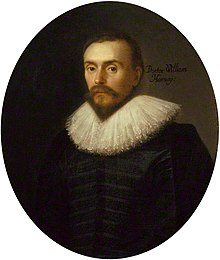
Back William Harvey Afrikaans ويليام هارفي Arabic ويليام هارفى (دكتور من مملكه انجلترا) ARZ William Harvey AST Vilyam Harvey Azerbaijani ویلیام هاروی AZB Уільям Гарвей Byelorussian Уилям Харви Bulgarian উইলিয়াম হার্ভে Bengali/Bangla William Harvey Breton
William Harvey | |
|---|---|
 Portrait attributed to Daniël Mijtens, c. 1627 | |
| Born | 1 April 1578 Folkestone, Kent, England |
| Died | 3 June 1657 (aged 79) Roehampton, London, England |
| Education | Gonville and Caius College, Cambridge University of Padua (M.D., 1602) |
| Known for | De Motu Cordis, 1628 (translated as Anatomical Account of the Circulation of the Heart and Blood in 1928) on systemic circulation |
| Spouse | Elizabeth Browne |
| Scientific career | |
| Fields | Medicine Anatomy |
| Doctoral advisor | Hieronymus Fabricius |
| Signature | |
 | |
William Harvey (1 April 1578 – 3 June 1657)[1] was an English physician who made influential contributions to anatomy and physiology.[2] He was the first known physician to describe completely, and in detail, pulmonary and systemic circulation as well as the specific process of blood being pumped to the brain and the rest of the body by the heart (though earlier writers, such as Realdo Colombo, Michael Servetus, and Jacques Dubois, had provided precursors to some of his theories).[3][4]
- ^ Cite error: The named reference
ODNBwas invoked but never defined (see the help page). - ^ Schuster, John A. (1996) [1990]. "Scientific Revolution". In Cantor, Geoffrey; Olby, Robert; Christie, John; Hodge, Jonathon (eds.). Companion to the History of Modern Science. Abingdon, Oxfordshire: Routledge. pp. 217–242. ISBN 978-0-415-14578-7.
- ^ "There's a reasonable basis to assume that it was Dr. Amatus who first discovered the "Blood circulation" phenomena". Archived from the original on 3 April 2013. Retrieved 8 December 2012.
- ^ Wilson and Aubrey (1962). "Malter Warner". Aubrey's Brief Lives. Michigan U. Press. p. 315. Retrieved 1 December 2012.